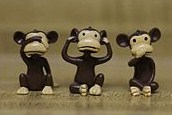12-spoke chakras are hung on the fences of construction sites “protected” by Barcelona’s gypsy gangs, and one is used as the favicon on the new website of local scrap-metal merchant Chatarrero Gratis BCN. Here it is:
The information at Romani.org suggests to me that depiction of Vishnu’s discus with only 12 spokes may constitute political apostasy:
In 1971 the International Gypsy Committee organized the first World Romani Congress. This took place in a location near London… funded in part by the World Council of Churches and the Indian Government; representatives from India and some 20 other countries were in attendance. At the congress, the green and blue flag from the 1933 conference, now embellished with the red, sixteen-spoked chakra, was reaffirmed as the national emblem of the Romani people, and the anthem, Dzelem dzelem, since sung at all congresses, was adopted. The World Romani Congress have adopted a Romani flag which is respected by all the Roma the world over. It comprises of blue and green traditional colors with the red wheel in the center. Blue is the blue sky and the heavens. Green is the land, organic and growing. The blue symbolizes eternal spiritual values; the green earthly values. The wheel in the center symbolizes movement and progress. It may not be out of place to point out here that the Indian national flag has also got [a 24-spoked] Ashok Chakra in the center.
The magnificent fist-fights witnessed at a congress of European gypsy nationalists (fully worthy of the parliaments of advanced democratic nations such as Italy and Japan) make one wonder whether it is smart to be non-conformist in the depiction of what in Hindu tradition is a ninja star boomerang of mass destruction. Donald Alexander Mackenzie in Indian myth and legend (1913) reminds us what a load of self-deceiving hippy bullshit the current Wikipedia chakra article is:
Vishnu is a dark god with four arms; in one of his right hands he holds a warshell, and in the other a flaming discus, which destroys enemies and returns after it is flung; in one left hand he holds a mace, and in the other a lotus bloom.
[…]
[It] was discovered that a demon named Rahu had assumed Celestial form with purpose to drink [the amrita]. The amrita had only reached his throat when the sun and moon discovered him and informed Vishnu. The divine Preserver then flung his discus and cut off Rahu’s huge head, which resembled a mountain peak. Rendered immortal by the amrita the head soared to the sky, roaring loud and long. From that day Rahu’s head, with mouth agape, has followed sun and moon, and when he swallows one or the other he causes the eclipses.
Meanwhile the demons fought against the gods, but were defeated, although they flung rocks and mountains. Thousands were slain by the sky-scouring discus of Vishnu, and those who survived concealed themselves in the bowels of the earth and the depths of the ocean of salt waters.
The first mention in the OED of the use of the chakra as a political symbol is in a resolution from the Constituent Assembly of India in 1947 (“The design of the Wheel shall be that of the Wheel (Chakra) which appears on the abacus of the Sarnath lion Capital of Asoka”), but what is the basis for the Indians having 24 spokes on theirs, international gypsydom 16, and Barcelona mafias only 12?
[
A serendipity: the Borgesian entry in the William Morton Bengali dictionary which relates
Vishnu, an emperor, the governor of a province, a potter, oilman, expresser of oil, an informer, a serpent, the ruddy goose, a tumbler or wheel-juggler
]
Similar posts
- Run like a gypsy
With Imanol Arias as El Lute, retired generaliser George Borrow, and walking and running style as social differentiators. - Effect of rainfall on wood ants and Ukrainians
Wood ants descending rapidly en masse from a Quercus ilex on Montseny at the onset of a sharp shower: Having spent several - Eye and Hand of Fatima on gypsy door in Perpignan
Efforts have been made to erase a sticker of a member of the Incredible Hulk clan. Superimposed on the wooden cross - Taken by the gypsies
Interesting report in this morning’s Vanguardia: The man who in mid-November calls the police station of the Mossos d’Esquadra in Vic says - Spider styles
Gerald Howson’s The Flamencos of Cadiz Bay is a damn good book that stays well clear of the “Andalusia, soul

On ‘private security’ (extortion racket) notices on building sites, I’ve seen it done Buddhist style with only 8 spokes.
I suppose you could view the flats in La Mina as a failed, minimalist pagoda.